Adaptive technology on the water: Our journey to enhance performance for a person with hemiplegia
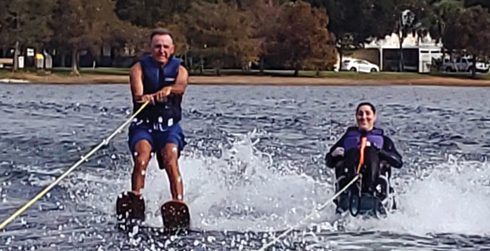
Lauren and Michael Toolan at Sugden Regional Park
General Overview
Participation in sports has a profound ability to empower the participant, while providing social connections and a wide array of health benefits. Sports can provide a transformative opportunity for people with a disability who may be coping with societal stigmas, limited access or equipment, and reduced self-efficacy and independence. However, these barriers may discourage those with disabilities from participating in physical activity that can promote physical, mental, and psychosocial health (Borland et al., 2020). Women with disabilities are especially vulnerable to reduced participation in sports due to both gender and disability discrimination, with 93% of women who have a disability not involved in any sporting activity (United Nations, n.d.). Occupational therapy can play an important role in supporting this population to overcome challenges and enhance opportunities for their participation in adaptive sports.
As occupational therapy professionals, we are uniquely trained to advocate for client-centered care that reduces barriers to participation in meaningful occupations and promotes overall well-being. When promoting participation in sports among clients with disabilities, incorporating ergonomically effective assistive technologies may be critical (Van der Woude et al., 2021). Practitioners may benefit from utilizing the Human Activity Assistive Technology (HAAT) frame of reference to guide their efforts. The HAAT model proposes that the human, desired activity, assistive technology, and context in which they are integrated must be considered for the design, selection, implementation, and evaluation of assistive technology (Cook and Polgar, 2012). With this framework in mind, our team of MSOT students and faculty at Florida Gulf Coast University (FGCU) set out to help a courageous adaptive wakeboarder to maximize her experience.
In 2021, FGCU alumni Lauren Horowitz reached out for assistance in her determined fight to overcome barriers interfering in her passion for wakeboarding, a popular water sport in which a rider stands on a board and is towed by a boat or an overhead cable, allowing them to perform various maneuvers over the wake. The board can be adapted for those who have difficulty standing by mounting a seat, known as a cage, to provide postural support. Lauren has cerebral palsy, limiting function on her right side—particularly in her arm. She was outfitted with an adaptive wakeboard when she began her journey into the world of wakeboarding in 2015 (see Figure 1). Participating in this sport increased her self-confidence by allowing her to focus on her abilities, instead of her limitations. However, her inability to use her right arm during wakeboarding prevented her from advancing her skills. Lauren worked with several experts in the field of adaptive water sports to improve her wakeboard setup until she was told, “This is as good as it’s going to get.” She reached out to FGCU for one final attempt to pursue her wakeboarding dreams. After speaking with Cori Bright-Kerrigan, the Director of the FGCU Office of Adaptive Services, Lauren was referred to Assistant Professor of Occupational Therapy Edwin Myers, OTD, OTR/L, ATP, who believed that occupational therapy could help her achieve her goal.
Figure 1. Lauren’s Original Adapted Wakeboard

Passion Project
Working with Lauren was a perfect fit for our Technology in Practice course, which offers a gamification format that allows students the opportunity to engage in interest-based projects. We were presented with the task to work with Lauren to reduce her barriers and maximize her wakeboarding performance. Prior to contacting us, her rope handle was modified so she could hold it with her left hand vertically between her knees to compensate for her right-sided hemiplegia. Lauren used this setup for several years, but she experienced fatigue and severe muscle strain in her left arm that typically limited her to two runs around the lake—preventing her from fully participating in the sport she loves.
The occupational therapy process began by interviewing Lauren and her spouse to understand their concerns. We then studied the existing equipment and recorded her physical performance measurements. An opportunity arose to observe her wakeboarding performance at an Adaptive Sports Day event held on campus at FGCU. We measured her grip strength using a dynamometer before and after a 5-minute ride and found that her grip strength decreased by 9 pounds during that time. She also reported that the effort to maintain control caused significant fatigue as well as pain in her left hand and shoulder. Based on these findings, we identified our key goals:
- Reduce load on the left upper extremity
- Provide flexible lumbar support to protect her back and improve core stability
- Provide grip support
- Increase the time spent wakeboarding without fatiguing
We began by searching for a conventional device that would allow for unilateral control of the wakeboard and would reduce the workload on Lauren’s left arm. One such option was the Delgar Sling (Liquid Access, 2022), which is a modified slalom handle that allows for single-arm control and is connected to a harness that distributes the rest of the load to the opposite shoulder. Unfortunately, this was not a suitable option for Lauren because she does not have the appropriate muscle tone and strength on her right side, and it would put her at risk of injury. We also considered the Goode PowerVest (Goode, 2022b) which connects the user’s gloves to a specially designed panel that distributes the pull across the torso, but it is not U.S. Coast Guard approved, which is a requirement at the wake park where Lauren rides. Finally, we found the Cape Reamol Wakebar and Loop Connector, (Cape Reamol, 2022). By having a secondary attachment via the loop connector, the wakebar reduces the force of the pull on the handle by 50%. The secondary attachment has a quick release design that releases as soon as tension is loosened by letting go of the handle. This is an important safety feature that prevents the user from being dragged in the water after a fall. One potential issue we found is that the Cape Reamol wakebar is meant to attach to a harness worn on the user’s waist. Because Lauren sits low in her adapted wakeboard cage with her hips at greater than 90° of flexion, the waist harness was not a viable option as designed. After consulting with Associate Professor of Bioengineering at FGCU, Derek Lura, PhD, we developed a plan to modify the wakebar by attaching it to the wakeboard cage. This modified wakeboard placement provided an attachment point for the loop connector. We predicted that these modifications would reduce the strain to Lauren’s left arm by 50% while allowing her to be safe and independent on the water.
The original design was developed to provide a connection point for the loop connector to the anterior vertical supports for the wakeboard cage. However, we found that a spreader bar was the standardized attachment for the loop connection. We purchased the spreader bar from a local kitesurf shop and revised the design to fit it under the seat by attaching it to the vertical supports with clamps. These clamps were designed in a 3D modeler, SolidWorks (Dassault Systèmes, 2022), and printed on an Ultimaker 5S 3D printer (Dynamism, 2022) in high performance polylactic acid (PLA+). We designed the clamps to be adjustable so that the height of the bar can be changed to manage the angle of the pull to improve how the wakeboard glides on the water (see Figure 2).
Figure 2. Spreader bar and lumbar support
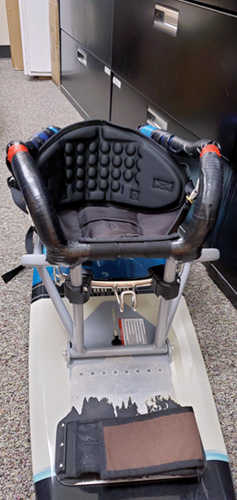
To provide lumbar support, we studied multiple devices to fit in the rear of the cage and determined that the Pactrade Marine adjustable kayak backrest, (Pactrade Marine, 2022), was the best fit. The backrest offers flexible support that allows Lauren to lean while maneuvering the board. To reinforce her grip, we found the Goode PowerGrip™ gloves, (Goode, 2022a), which are designed with a double-stitched Kevlar® palm, pre-curved fingers, and two power wrist straps for enhanced fit and grip.
After all the components were assembled (see Figure 3), we engaged in a series of performance tests utilizing a BTE Primus RS owned by the FGCU OT Program. The Primus RS is a work simulator capable of recreating movements of several work- and leisure-related activities. By simulating the angle and force of pull on the wake line, we determined that the modifications were mechanically sound and able to withstand the forces Lauren would encounter on a lake. We also tested the quick release and found that it reliably freed the connection when the handle was released to ensure Lauren’s safety in preparation for her trials on a lake.
Figure 3. Updated wakeboard configuration
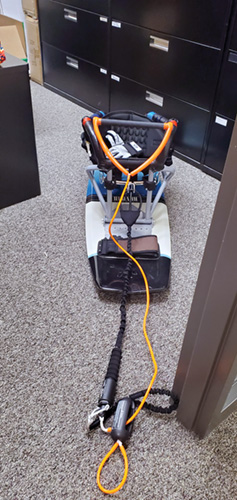
To test our design on the water, we worked with Michael Toolan, supervisor of the Collier County Ski Center at Sugden Regional Park. Michael partners with the Freedom Waters Foundation to provide adaptive sailing opportunities for individuals with disabilities and has worked with adaptive skiing through Ann’s Angels Adaptive Waterski Foundation. Michael graciously accepted our request to take Lauren out on the lake with her new gear, and the trials were a success (see Figure 4)! Lauren completed 5 trials on the lake with more than 20 minutes of ride time, reporting significant reduction in her fatigue and no increase in pain. Lauren beamed as she described her elation, stating, “This is life changing! I feel like we have finally arrived at a solution after all this time.”
Figure 4. Successful launch from platform
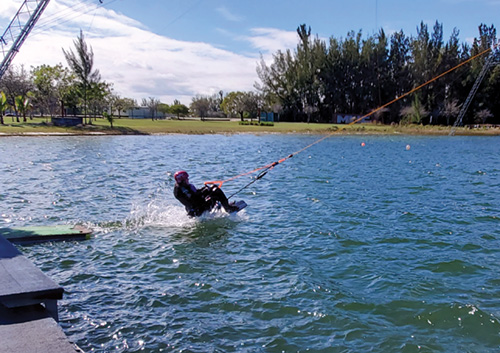
The next step was to test her new model at Miami Watersports Complex, her home base for wakeboarding (see Figure 5). With the custom modifications, Lauren completed seven rides with no fatigue or decrease in grip strength!
Figure 5. Test ride at Miami Watersports Complex
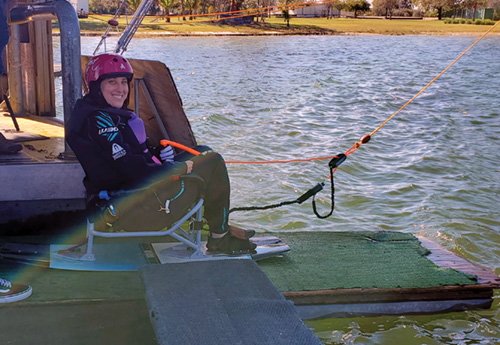
In a thank you letter to our team, Lauren conveyed to us the positive impact the project had:
Having a physical disability often requires that I become an advocate or inventor to be able to do things others take for granted. Thanks to your help, I was able to fully participate in a sport that would forever change my life, one that means so much to me—not just for my physical well-being but also my emotional health. I feel a sense of calm or freedom on the water I don’t otherwise get in my everyday world. Team Eagle (the project’s contributors) united and helped me in more ways that I can even express. Thank you from the bottom of my heart. Each and every one of you played a role to transform my ability to be fully successful in my sport.
This experience highlights the power of interdisciplinary collaboration and the opportunity for occupational therapy practitioners in the world of adaptive sports to enhance client performance, well-being, and quality of life through promotion of physical activity and the use of assistive technology, through a holistic, occupation-based lens. The success of this project with Lauren is ongoing. We are now focusing on biomechanical factors with Lauren by designing an exercise program to enhance her skills and independence so that she may have long-term enjoyment of this sport for which she has such great passion.
References
Borland, R. L., Hu, N., Tonge, B., Einfeld, S., & Gray, K. M. (2020). Participation in sport and physical activity in adults with intellectual disabilities. Journal of Intellectual Disability Research, 64, 908–922. https://doi.org/10.1111/jir.12782
Cape Reamol. (2022). Wakeboard and loop connector. https://www.capereamol.com/shop/wakebar-loop-connector.html
Cook, A. M., & Polgar, J. M. (2012). Essentials of assistive technologies. Elsevier.
Dassault Systèmes (2022). SolidWorks. https://www.3ds.com/
Dynamism (2022). Ultimaker 5S. https://www.dynamism.com/ultimaker.html
Goode. (2022a). Goode PowerGrip™ gloves. https://goode.com/products/powergrip%E2%84%A2-gloves-with-kevlar-palm-neoprene-backing
Goode. (2022b). Goode PowerVest™. https://goode.com/products/goode-powervestLiquid Access. (2022). Delgar Sling. https://liquidaccess.org/shop/delgar-sling/
Pactrade Marine. (2022). Pactrade Marine Adjustable Straps Black Padded Kayak Back Canoe Backrest Support Comfy Cushion. https://www.pactrademarine.com/kayak-accessories-c-57/pactrade-marine-adjustable-straps-black-padded-kayak-back-canoe-backrest-support-comfy-cushion-1-p-2331.html
United Nations. (n.d.). Disability and sports. https://www.un.org/development/desa/disabilities/issues/disability-and-sports.html
Van der Woude, L. H. V., Houdijk, H. J. P., Janssen, T. W. J., Seves, B., Schelhaas, R., Plaggenmarsch, C., …Vegter, R. J. K. (2021). Rehabilitation: Mobility, exercise & sports: A critical position stand on current and future research perspectives. Disability and Rehabilitation, 43, 3476–3491. https://doi.org/10.1080/09638288.2020.1806365
Laura Clark, OTS, and Danielle Iqbal, OTS, graduated on May 8, 2022, from Florida Gulf Coast University’s Master of Science in Occupational Therapy program.
Edwin Myers, OTD, OTR/L, ATP, AOTA RA CRAC Chair, is an Assistant Professor in the FGCU MSOT program. He has more than 30 years of clinical experience and is a certified ATP with RESNA specializing in seating and wheeled mobility.
The authors would like to acknowledge and express their appreciation to faculty advisor, Derek Lura, PhD, FGCU, Associate Professor of Bioengineering, for his consultation and expertise throughout the process; and to thank the members of Team Eagle: Megan Hendrix, OTS; Chloe Jackson, OTS; Kaelee McDowell, OTS; Grace Precord, OTS; and Adrienne Yaryan, OTS.